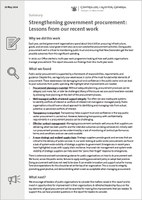Summary of our report
Why we did this work
 Each year, central government organisations spend about $52.5 billion procuring infrastructure, goods, and services. Local government also carry out substantial procurement activities. Doing public procurement well is critical to maintaining public trust and ensuring that New Zealanders get the best possible outcomes from this significant spending.
Each year, central government organisations spend about $52.5 billion procuring infrastructure, goods, and services. Local government also carry out substantial procurement activities. Doing public procurement well is critical to maintaining public trust and ensuring that New Zealanders get the best possible outcomes from this significant spending.
In 2018, our Office started a multi-year work programme looking at how well public organisations manage procurement. This report discusses our findings from this multi-year work.
What we found
Public sector procurement is supported by a framework of responsibilities, requirements, and guidance. Despite this, we regularly saw weaknesses in some of the most fundamental elements of procurement. These weaknesses risk damaging trust and confidence in the public sector and can lead to poor outcomes from public spending. We highlight what improvements are needed:
- Procurement planning is essential: Without adequate planning, procurement processes can be delayed, cost more, fail, or later be challenged. Many of the issues we saw could have been avoided by allowing more planning at the start of the procurement process.
- Well-managed conflicts of interest support integrity: Too often we saw inadequate systems to identify conflicts of interest or conflicts of interest not managed or managed poorly. Public organisations should have a robust approach to identifying and managing risks from actual, potential, or perceived conflicts of interest.
- Transparency is important: Transparency helps support trust and confidence in the way public sector procurement is carried out. However, balancing transparency with confidentiality requirements in a procurement process can be challenging.
- Effective contract management: Managing procurement contracts well ensures that suppliers are delivering what has been paid for and the intended outcomes are being achieved. An initially well-run procurement process can be undermined by a lack of monitoring of contract performance, terms, and conditions and can see costs escalate.
- A more strategic and resilient supply chain: Strategic suppliers provide goods and services that are critical to the delivery of public services. In our work looking at public sector procurement, we found a lack of system-wide visibility of strategic suppliers to government. Emergencies in recent years have highlighted issues with supply chain resilience. Improved risk management and system-wide visibility of strategic suppliers can help avoid the “panic then forget” response to emergencies.
There is extensive and well-considered guidance for public organisations on how to do procurement well. We found, across the public sector, failures to apply existing procurement policy or adopt best practice. Doing procurement well does not need to be slow. It can enable innovation and support value for money. Tone and expectations for this should be set at the top of an organisation. This is crucial to integrity, promoting good practice, and demonstrating what is seen as acceptable when managing procurement.
What next?
We encourage all leaders of public organisations to consider the matters raised in this report and to invest in opportunities for improvement in their organisations. A refreshed leadership focus on the key elements of good procurement will be essential for making the improvements that are needed. To support this, we have provided questions in the report for leaders to consider.

